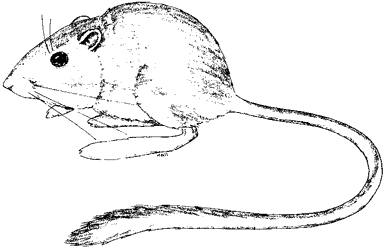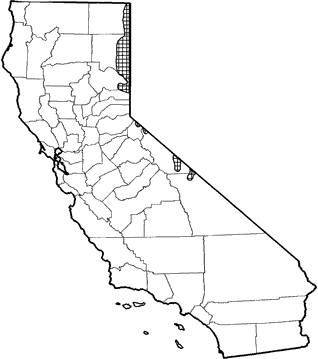
Ord's Kangaroo Rat
Distribution, Abundance, and Seasonality
Present in 2 disjunct areas in the northeastern and east-central sections of the state. In northeastern California, from Goose Lake (Modoc Co.) south to vicinity of Beckworth Pass (Plumas Co.), and in the vicinity of Woodfords (Alpine Co.) (Grinnell 1922). In east-central California, in vicinity of Benton Station and Benton Hot Springs in the north end of Owens Valley (Mono Co.). Common in sparse to moderately dense sagebrush, low sage, and alkali desert scrub habitats; less common in dense canopy of these habitats. Bitterbrush and pinyon-juniper are marginal habitats.

Range Map
Specific Habitat Requirements
Feeding: Diet includes seeds of grasses, forbs, and shrubs, leafy vegetation, and some insects.
Cover: Burrows are excavated in sandy or gravelly soil at the bases of shrubs or edges of rocks.
Reproduction: The female lines the nest chamber with dry grass parts (Hall 1946).
Water: Water is obtained metabolically from food, and from moisture in food. Will drink water when available (Burt and Grossenheider 1976).
Pattern: Desert scrub flats with moderate canopy coverage and gravelly soils are preferred.
Species Life History
Activity Patterns: Yearlong nocturnal activity. Like other heteromyids of its size, shows reduced surface activity in periods of food stress and cold spells.
Seasonal Movements / Migration: None
Home Range: In New Mexico, home range averaged 1.4 ha (3.4 ac) (Blair 1943).
Territory: Aggressively solitary. Territory probably equals home range.
Reproduction: Breeds from January into March, the onset depending upon the severity of winter. Litter size averages 2-4. May breed again in September or October (Duke 1944).
Niche: D. ordii is a small to medium-sized, relatively short-tailed, inhabitant of sandy sagebrush flats. Some sympatric heteromyids are Microdipodops spp., D. microps, D. panamintinus, Perognathus parvus, and P. Iongimembris. Predators include owls, foxes, coyotes, bobcats, badgers, and snakes.
Sources & References
California Department of Fish and Game, 1999.
California's Wildlife, Sacramento, CA.
Written by: P. Brylski, reviewed by: H. Shellhammer, edited by: R. Duke
Blair, W. F. 1943. Populations of the deer mouse and associated small mammals in the mesquite associations of southern New Mexico. Contrib. Lab. Vertebr. Biol. Univ. Mich. No. 21. 40pp. Burt, W. H., and R. P. Grossenheider. 1976. A field guide to the mammals. 3d ed. Houghton Mifflin Co, Boston, MA. 289pp. Duke, K. L. 1944. The breeding season in two species of Dipodomys. J. Mammal. 25:155-160. Grinnell, J. 1922. A geographical study of the kangaroo rats of California. Univ. Calif. Publ. Zool. 24:1-124. Hall, E. R. 1946. Mammals of Nevada. Univ. California Press, Berkeley. 710pp.
California Animal Facts | California's Wildlife